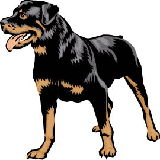Big DogsInformation About The Japanese Akita Dog Breed |
|
|
History and origin : The Japanese Akita was named after the Akita province in Japan on the island of Honshu. This breed was initially developed as a versatile hunting dog with power, size, a good sense of smell, insulation against the cold, and a dominant, aggressive nature that enabled him to deal with bears,deer, and wild boars. Over the centuries the Akita came to be revered as a noble breed and a spiritual symbol of loyalty and beauty. Description : The Akita stands 24 to 28 inches at the shoulder and weighs between 80 and 110 pounds. He is thick-boned and has a large, powerful body. The harsh, shedding coat is of medium length with a thick, dense undercoat. This breed sheds year-round and requires daily brushing. Colors include white, brindle, white with tan patches, and other combinations. About the breed : This is an intelligent, strong, athletic, personable breed that is extremely faithful and affectionate to his owners. Although the Akita is usually easygoing in the home, he may exhibit marked territorial instincts, showing a reserved, suspicious nature with strangers. This dog will constantly contend for the dominant position and will use his body and mouth to exert control over those in the family who have not yet established dominance. Aggression toward family members is common when leadership is not established. Do not roughhouse with this breed. He can be very dog-aggressive and has a high prey drive toward small animals. This breed may not do well with small children. Obedience training, socialization, and handling must start early and must be firm, precise, and patient. He is very stubborn and may occasionally throw a tantrum when resisting. The Akita is one of the more difficult breeds to train. Both sexes are susceptible to urinary tract infections when young and are hard to housebreak. They can also be prone to hip dysplasia. If you decide on a male, have him neutered by the seventh or eighth month. This will make training easier, will reduce aggression and dominance problems, and can prevent marking in the house. Do not buy litter mates, they will bond more closely to each other than to you, making control a major issue. They will also exhibit more territorial aggression. This breed loves cold weather and likes to play in the snow. Do not get one if you live in a warm climate. Avoid jogging with this breed, as he is big-boned and heavy and might develop arthritis later in life.Feeding : Recommended feeding for the Japanese Akita is 1 ½ - 2 ½ cans (13.3oz) of high-quality meaty product with biscuit added in equal amount or 5 cupfuls of complete, dry dog food. Ideal home : The Japanese Akita needs a house with a fenced yard. The owner of this breed must be a natural leader and should desire an affectionate, independent dog that will be a challenge. Overbearing, submissive, nervous, and cautious people should avoid this breed, as should those with small children. The owner must be up to the physical challenge as well, as these dogs are very large and powerful. Because of this, he is not recommended to the elderly and the disabled. The owner of an Akita must find the time to train, socialize, handle, and groom the breed and must not keep him exclusively in the yard, where he will become noisy, territorial, and destructive.Back to the Big Dog Breed article page
| |
|
Related News About Dogs ' ); // get rid of newsfeed display by carp CarpConf('poweredby',''); CarpCacheShow('http://classifieds.agriscape.com/syndicate/dogs.rss'); ?>
|
|
|
|
|
|
Copyright © 2006-2007 dogguidance.com |


